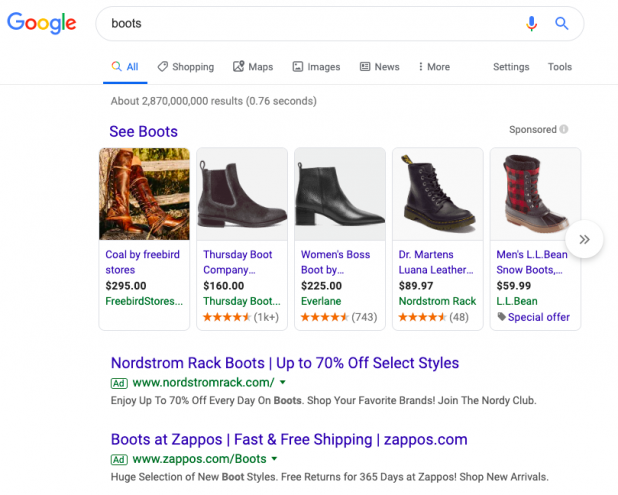Search ads benefit both search engine users and online publishers.
Three-fourths of people say paid search advertisements help them find the information they’re searching for online, according to a survey from Clutch.
If people find your ads useful, your business can improve your brand awareness and earn high-quality site traffic.
In fact, search ads can improve top-of-mind awareness by an average of 80%, according to a meta-study performed by Google and Ipsos MediaCT.
Processing 3.5 billion queries every single day, Google is the go-to search engine. As the primary source of information for people online.
Given its popularity, Google Ads is naturally where your business should direct search engine marketing (SEM) dollars.
For retailers, though, it’s crucial to think about how to extend your SEM beyond just Google.
Use this article to format your SEM strategy to target users across other major search engines and engage your target customers.
Use Inbound Marketing Methodology for Your SEM
Most marketers say that inbound practice provided the highest quality leads for their sales teams.
With inbound, you’re focusing on consumers who are already looking for information related to your service or product, increasing the chances of conversions.
Specifically, it allows your company to meet customers where they are – search engines, social media, etc.
SEM helps improve the chances that people encounter your company on search by appearing at the top of search results pages.
When they encounter your company first, people are more likely to develop trust for your brand. Web users consider the first several websites of the search engine results page (SERPs) as the most trustworthy businesses in their industry.
It’s important that you keep this customer-centric inbound approach in mind to increase your chances of conversions on search.
Keywords Are Critical
Keyword research is the core of any effective SEM efforts.
Ranking first on a search engine results page (SERP) for a term or phrase results in a 40% organic click-through rate, more than double the effectiveness of ranking second (15%) or third (9%).

When determining which keywords to target, consider:
- Relevant, high-intent keywords: The keywords you bid for should align with the terms people use to search for products you sell.
- Structured ad groups: Consider creating and bidding on groups of similar terms that can help you establish visibility for a range of phrases people would use to find your products.
- Negative keywords: Ensure that you don’t advertise for terms that are either irrelevant or won’t realistically lead to conversions for your company.
Once you have determined the keywords you’ll focus on for your SEM strategy, you need to focus on how you’ll segment your ads across search engines.
Adjust Your SEM Approach Based on Search Platform
Google is the most popular paid-per-click (PPC) advertising platform, which makes keyword searches particularly competitive.
To distinguish your company from other retailers, expand your SEM efforts across multiple platforms
Although Google is the most used search engine, expanding your firm’s SEM strategy to include Bing, YouTube, or Amazon can help reach a wider audience.
One reason a diversified strategy creates benefits is due to the different formats of each platform.
Google, for example, has a horizontal display of shopping and product listings that make ranking above other retailers and organic results less important.
Still, companies targeting mobile audiences should maintain optimizing for top listing as a priority. Paid ads often display above the fold on a mobile interface, which essentially hides organic results.
Amazon and Bing Help Reach Targeted Audiences
People’s preference for paid search ads relates to their intent.
For example, people use Google to find answers to questions. Since text is generally the best method to achieve that, users who click on Google ads prefer text ads, according to Clutch’s survey.
Amazon, on the other hand, gives access to products for purchase. As a retailer, you can be confident that people have more intent to purchase something than audiences of a Google search.
Unsurprisingly, Clutch found that 50% of people engaging with Amazon ads favor shopping or product listings.
Bing, for its part, actually has a 34% higher click-through rate than Google Ads and tends to appeal to an older audience: 40% of its users are ages of 35 – 45, whereas Google users on average skew lower.
If your target customers fall within the demographics of a less popular search engine, consider planning and dedicating some of your SEM strategy to those platforms.
Retail Businesses Can Rely on SEM to Engage Target Customers
As consumers lives become increasingly online, retailers cannot afford to neglect a digital marketing strategy. Luckily, there are many ways to successfully engage SEM.
By reviewing and targeting relevant keywords and structuring your SEM strategy according to which search engines your audience frequents, you can improve your marketing operations online for your retail brand.





